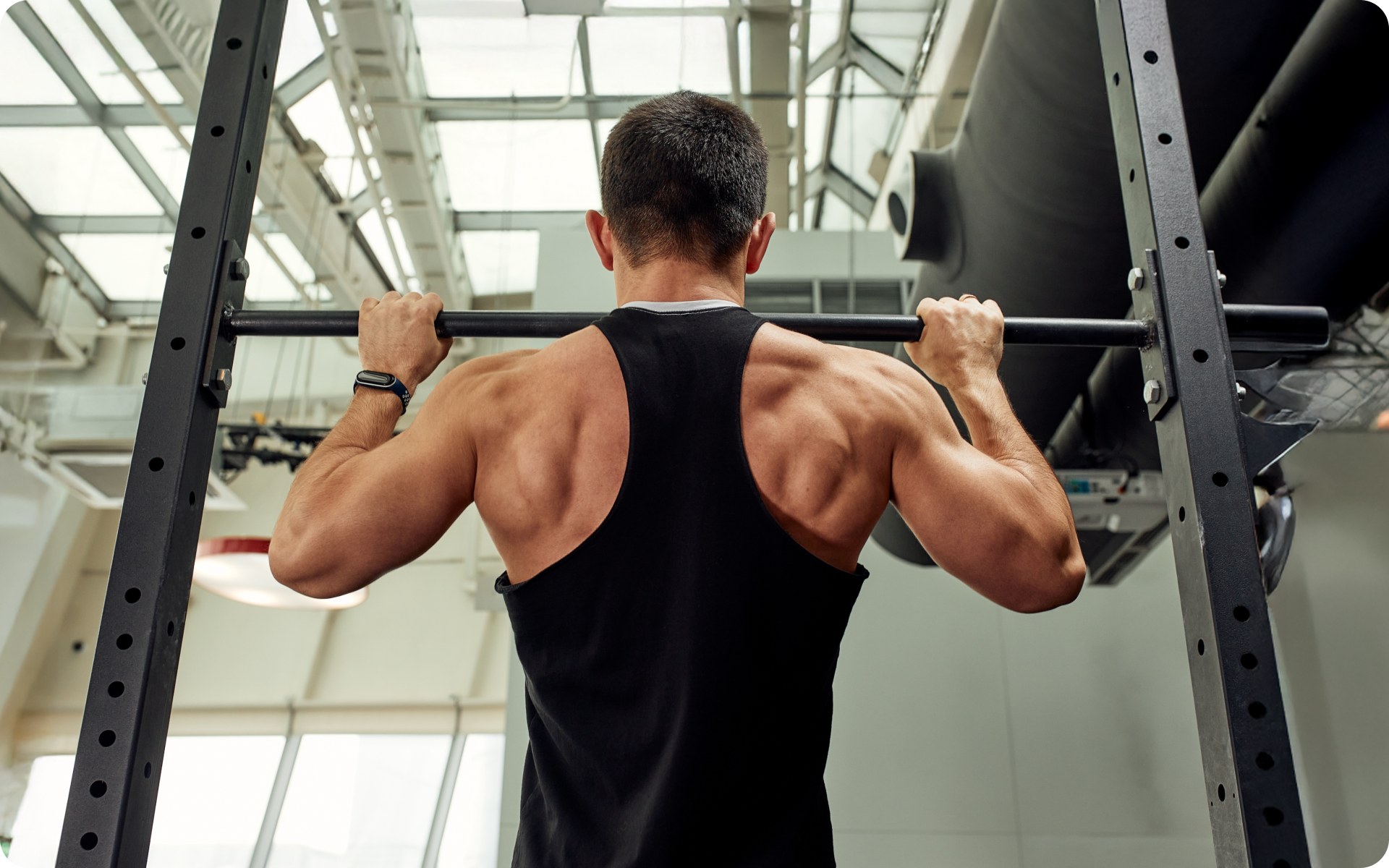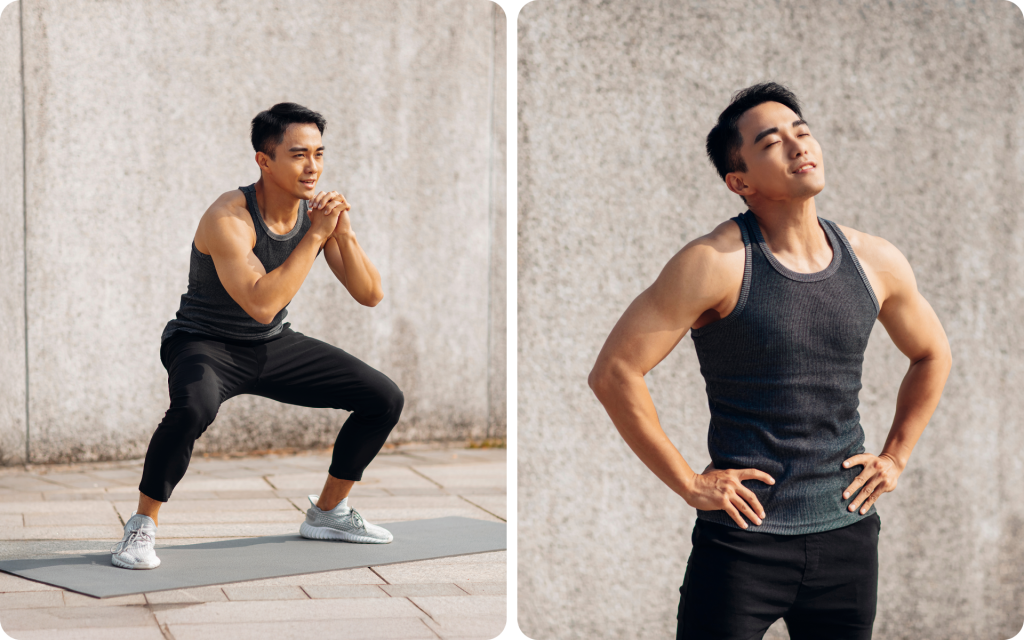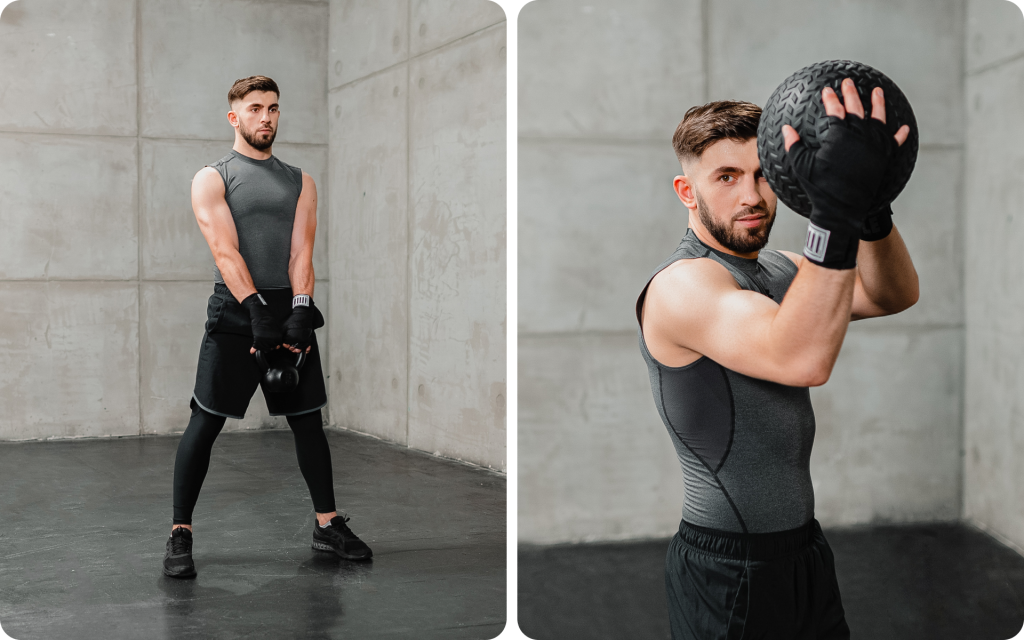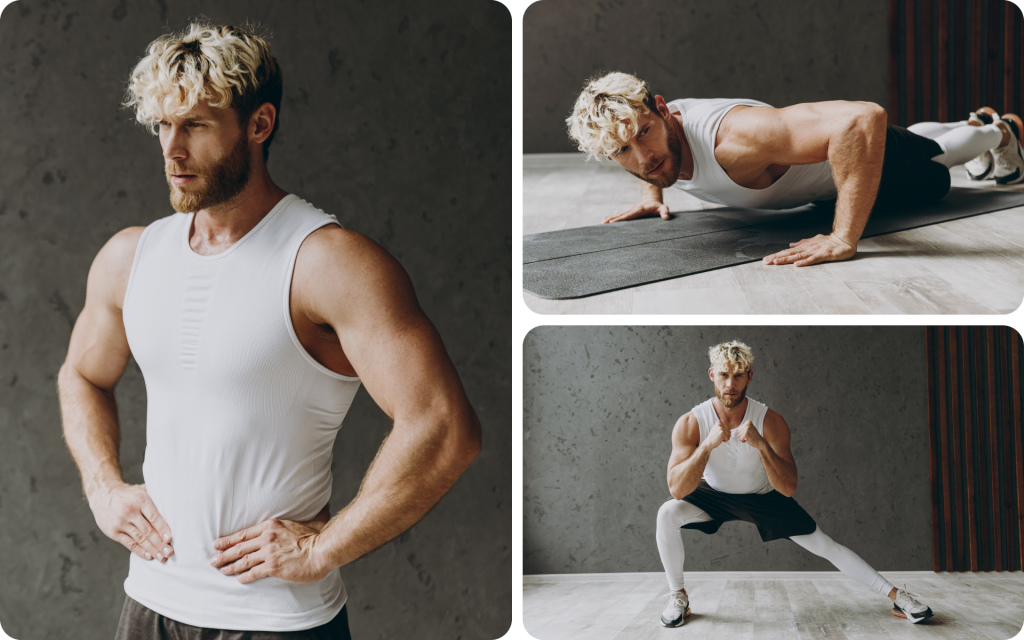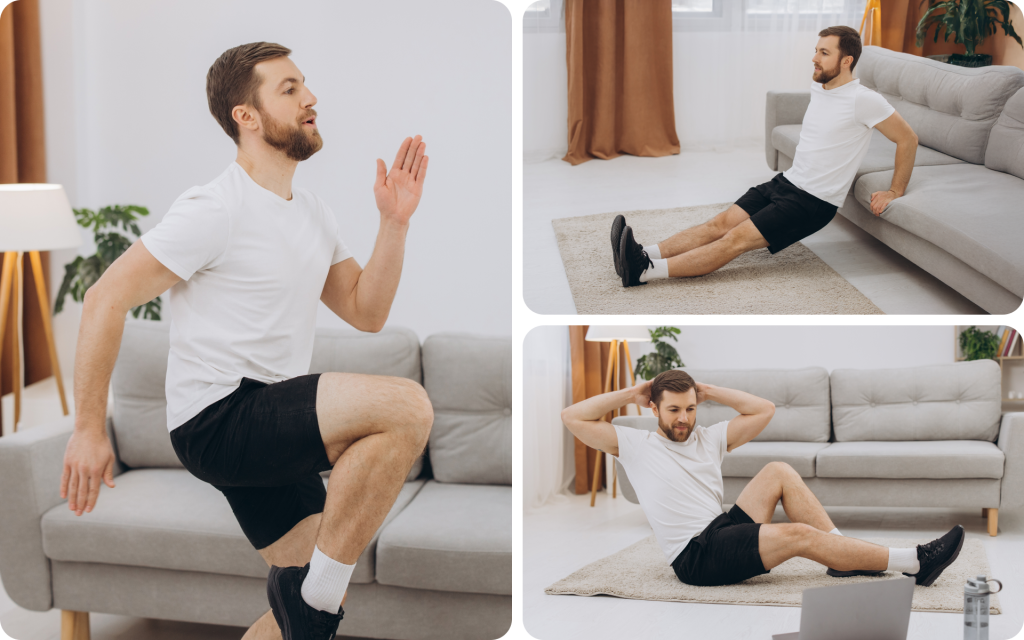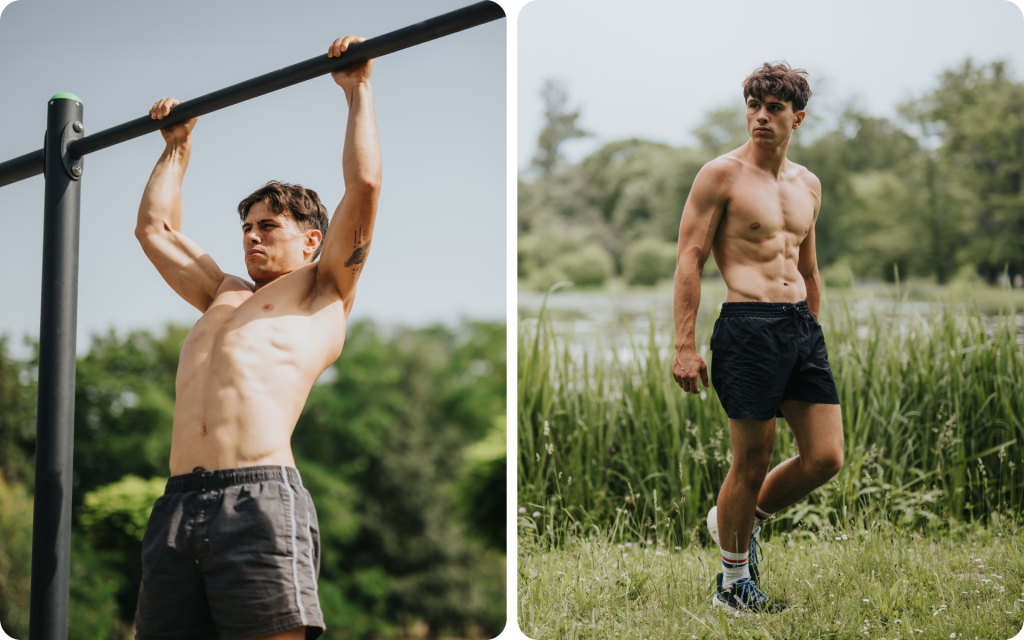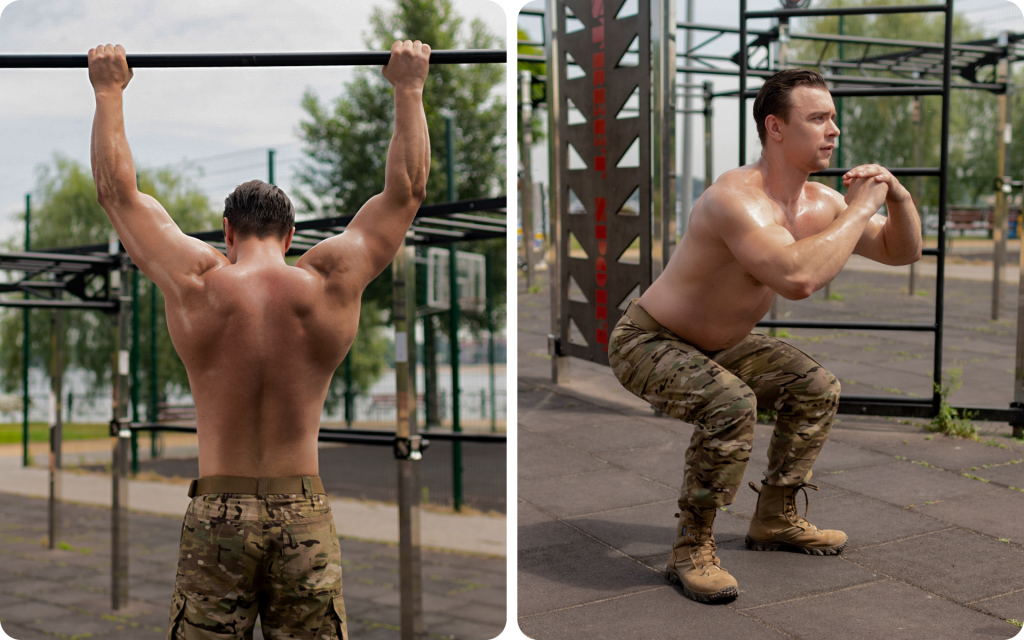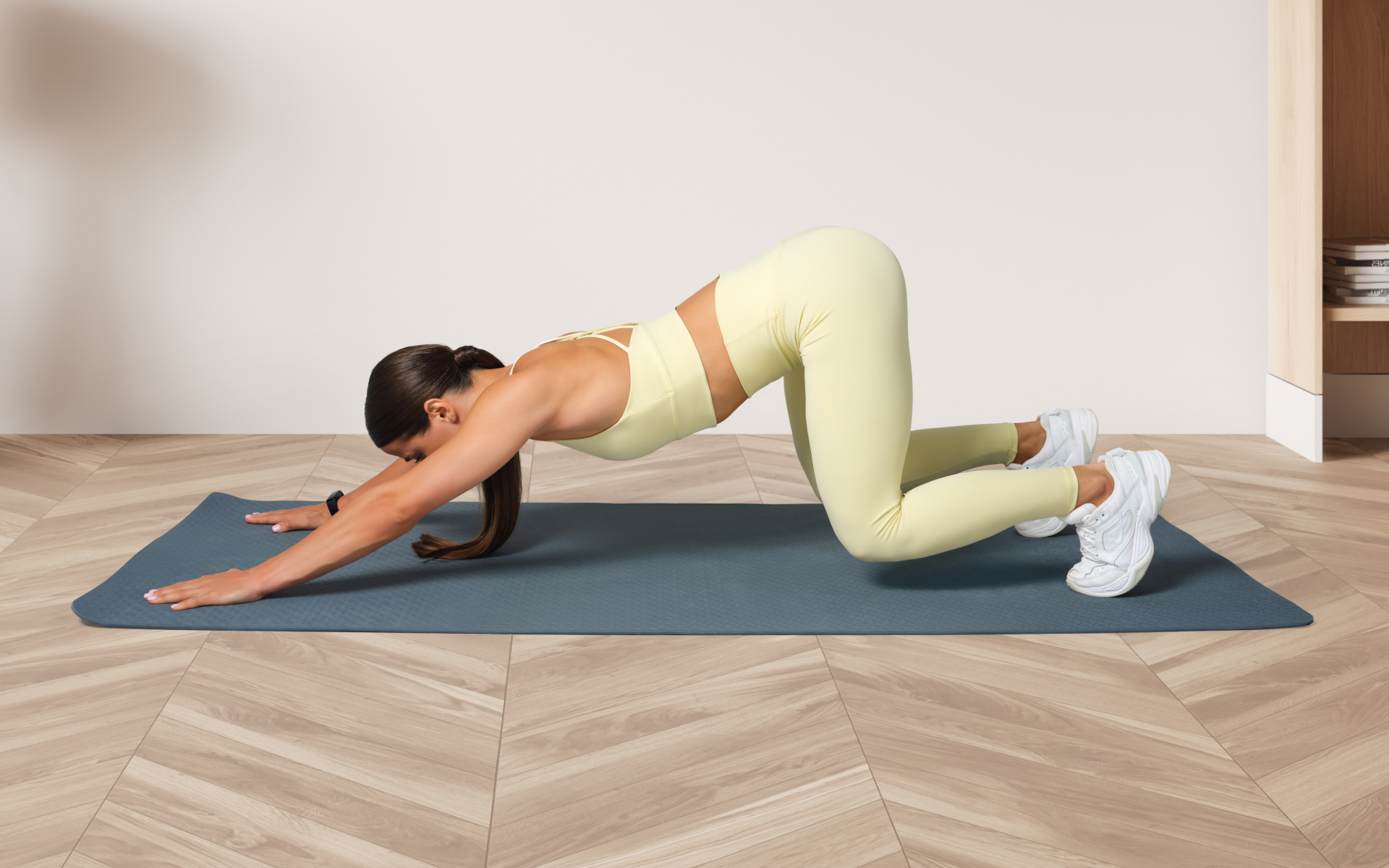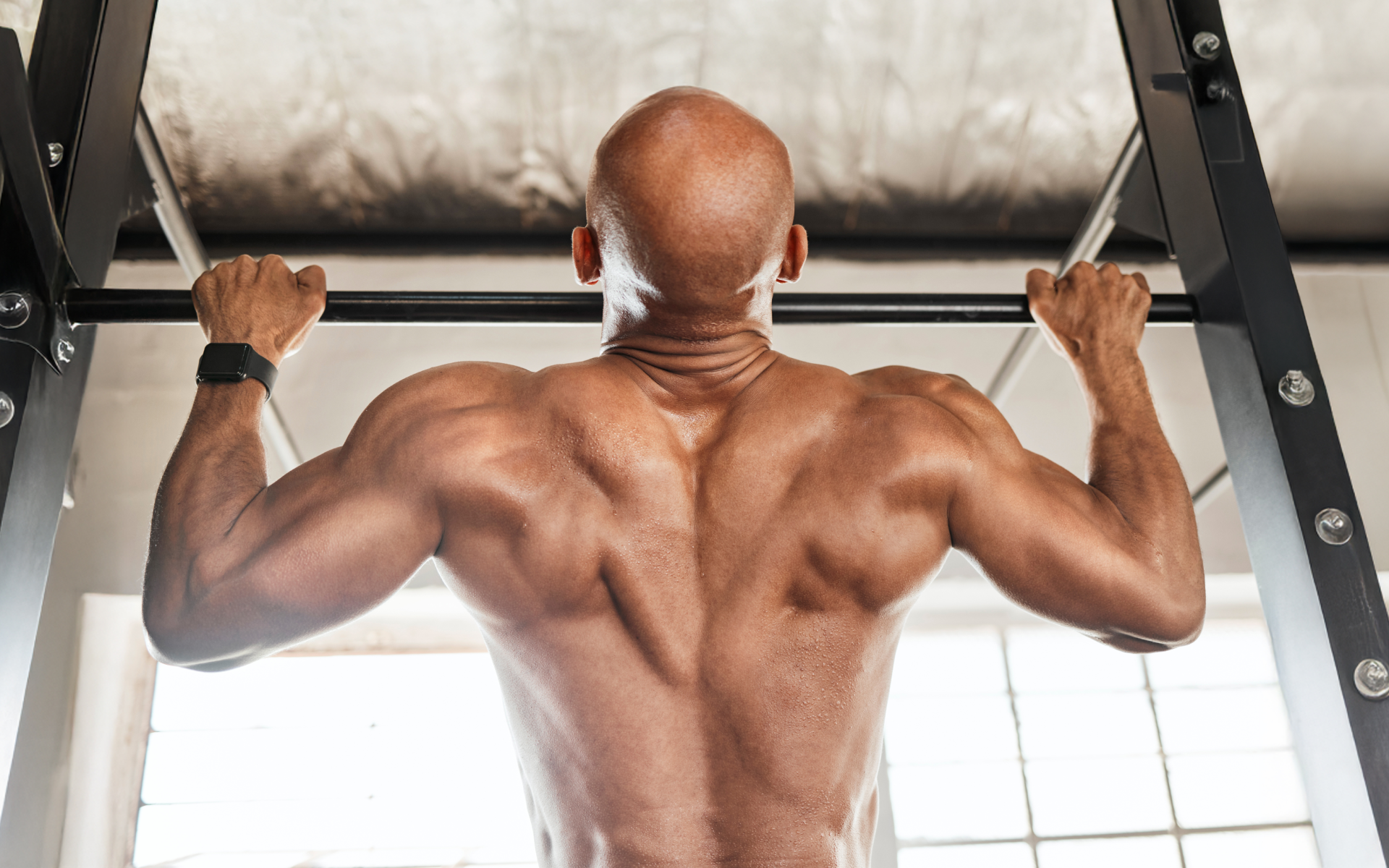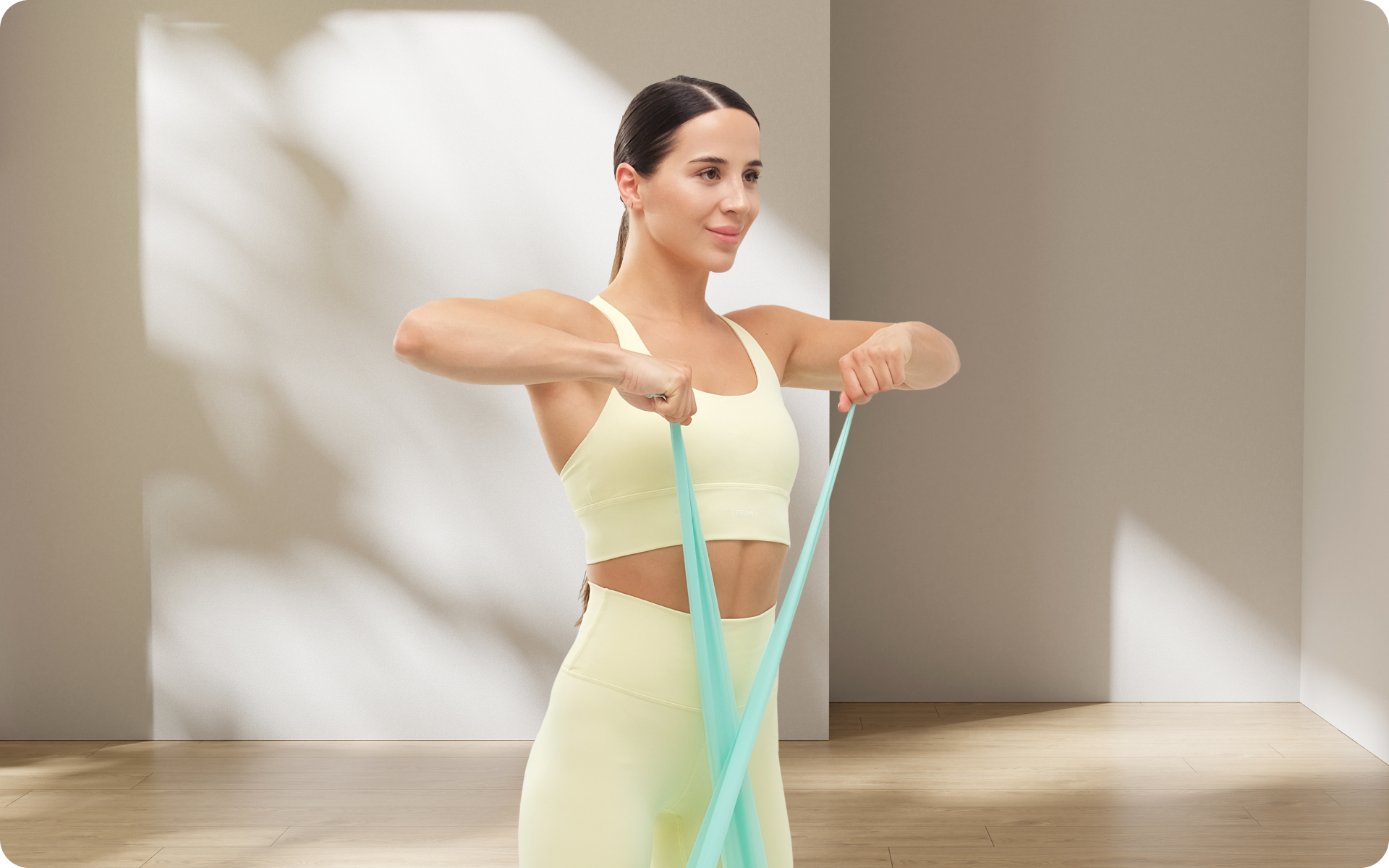A back and biceps-focused day is a classic pairing within split training. These muscle groups work together during many pulling movements, which makes them an efficient combination to target in the same session. A properly designed back and bicep workout strengthens your upper body and improves your functional movements, posture, and overall pulling power.
In this article, we guide you through the principles behind a killer back and bicep routine, providing exercises and form tips to help you move smarter and train effectively.
Should I Train Back and Biceps on the Same Day?
When designing an effective workout program, one fundamental consideration is how to group muscle groups for training. Pairing back and biceps on the same day is a strategy that is rooted in efficiency and biomechanics.
Let’s break down the reasoning behind this approach.
1. Complementary Function During Pulling Movements
The back and biceps play a synergistic role in pulling exercises. Major back muscles, such as the latissimus dorsi, trapezius, and rhomboids, are the primary movers in exercises such as rows, pull-ups, and lat pulldowns. However, the biceps brachii, which flexes the elbow, acts as a key secondary muscle during these movements.
By training these groups together, you capitalize on the natural pairing of their functions. For example, if you perform a pull-up, your back does the heavy lifting, while your biceps assist. Once your back is pre-fatigued, you can shift to isolating your biceps, which makes the session both logical and efficient for muscle recruitment and progress.
2. Improved Recovery and Reduced Overlap
One of the principles of strength training is to ensure each muscle group has adequate time to recover before its next demanding session (1). Training your back and biceps on the same day allows you to isolate pulling-related movements to a single workout, reducing overlap with other sessions. If you separate back and biceps across different workouts, you risk overtraining the biceps due to their involvement in nearly every pulling motion, which can lead to stagnation, increased soreness, and injury over time.
By grouping the back and biceps into the same workout, you train smarter, not harder. This approach prioritizes recovery and ensures your next training session (chest, legs, or another split) won’t inadvertently tax these already-worked muscles.
3. Efficiency in Program Design
For busy individuals or athletes who are managing tight schedules, it’s important to maximize gym time without compromising results. Training the back and biceps together eliminates redundancy and streamlines your workout routine, allowing for a more balanced training week. It’s particularly beneficial for those who are adhering to a traditional “bro-split” or upper/lower split, as this pairing helps maintain structural symmetry while ensuring every muscle gets an adequate workload.
In addition, sequencing exercises from compound to isolation within a session keeps energy expenditure logical. You’ll engage large muscles (back) first when you’re strongest, then isolate the smaller biceps toward the end of your workout when localized fatigue is less impactful.
Whether you’re looking to simply pep up your fitness routine, jazz up your diet with mouth-watering low-calorie recipes or want to get your act together and significantly drop that number on your scale – BetterMe: Health Coaching app has got you covered! Improve your body and revamp your life!
4. Neuroscience of Muscle Coordination
From a neurological standpoint, pairing these muscle groups leverages efficient motor unit recruitment. Performing compound pulling movements activates the neural pathways that are associated with coordinated back and biceps activity. This primes your nervous system for higher biceps activation during isolation exercises. Essentially, your brain has already “warmed up” the same motor patterns, which can enhance focus, contraction, and performance during bicep-focused lifts.
Furthermore, this coordination reduces cognitive fatigue. Instead of switching between unrelated movement patterns (such as training legs and biceps on the same day), focusing on related groups keeps your workout flowing smoothly, which minimizes mental exhaustion.
5. Supporting Functional Strength and Posture
By training your back and biceps together, you’re building muscle and reinforcing the functional strength that is needed for daily tasks and athletic performance. Strong pulling power translates to better posture by combating forward shoulder rounding and imbalances that are caused by prolonged sitting or excessive pushing motions. Combining this with targeted biceps work will ensure a well-rounded upper body that is capable of handling both strength demands and aesthetic goals.
Read more: Calisthenics for Skinny Guys: 8 Exercises to Build Muscle
How to Train the Back and Biceps Together
When training the back and biceps together, the goal is to create a balanced and effective session that maximizes both strength and hypertrophy. Below are actionable steps to structure and execute this workout, ensuring it is aligned with both your short-term goals and long-term health.
- Warm Up Strategically
Start with a dynamic warm-up that prepares your muscles and nervous system for the session (2). Focus on movements that target both mobility and activation in your upper body. Examples include arm circles, thoracic spine rotations, and band pull-aparts.
Follow this with light sets of pull-ups or lat pulldowns, gradually increasing intensity to activate your lats and ensure proper blood flow to your biceps. This primes your neuromuscular pathways and reduces the risk of injury.
- Start with Compound Back Movements
Always lead with exercises that target your larger back muscles and involve multiple joints. Compound movements such as deadlifts, barbell rows, or weighted pull-ups recruit numerous muscle groups and require the most energy (3). Aim for 2-4 sets of 6-12 reps, depending on your training goals.
These exercises challenge your back and engage your biceps as secondary movers, setting the stage for efficient muscle recruitment later in the session.
- Incorporate Targeted Back Isolation
After completing compound exercises, move to back-focused isolation movements. These exercises help you emphasize specific muscles, such as the rhomboids or rear deltoids, for a more balanced back. Cable face pulls, straight-arm pulldowns, or dumbbell reverse flyes are excellent options.
This step ensures that smaller stabilizing muscles aren’t overlooked and can contribute evenly to your overall back strength and posture.
- Transition to Biceps Isolation
Once your back is adequately fatigued, shift your focus to targeted biceps exercises. Start with movements that allow for full range of motion and controlled contraction, such as standing barbell curls or incline dumbbell curls.
Perform 3-4 sets of 8-15 reps, prioritizing strict form over heavy loads. This ensures optimal stimulus without overloading the joints or sacrificing technique.
- Alternate Back and Bicep Movements (Optional Supersets)
To save time and maintain intensity, consider alternating back and bicep exercises or incorporating supersets. For example, pair seated cable rows with hammer curls or lat pulldowns with concentration curls.
This approach maintains a steady workload while providing a metabolic boost, which is ideal for those who are managing tight schedules or working toward fat loss.
- Prioritize Recovery Between Sets
While it’s tempting to minimize rest for a faster workout, remember that both the back and biceps are heavily involved in pulling movements. Give yourself sufficient rest between sets, typically 60-180 seconds for compound lifts and 45-90 seconds for isolation exercises (4).
Quality movement and muscle activation should always take precedence over rushing through your routine.
- Cool Down and Stretch
End your session with mobility work and stretching to enhance recovery and maintain joint health (5). Target your lats, traps, and biceps with stretches such as the doorway lat stretch or biceps wall stretch. Incorporate deep breathing to activate the parasympathetic nervous system, further aiding relaxation and recovery (6).
Taking the time to cool down benefits both your muscular system and your mind, which leaves you refreshed for your next workout.
What to Do for Back and Bicep Day
On a back and bicep day, the goal is to structure your workout in a way that maximizes efficiency, strength, and hypertrophy. Start with a comprehensive warm-up that targets the muscles and joints involved. Incorporating light pulling exercises, dynamic stretches, and mobility work for the shoulders and thoracic spine will help prepare your body for the session.
Start the workout with compound back exercises such as pull-ups, barbell rows, or deadlifts. These movements recruit multiple muscle groups and build foundational strength. Next, focus on isolation exercises for more specific muscle activation, such as single-arm dumbbell rows or cable face pulls. Once your back is thoroughly worked, transition to biceps-specific exercises such as barbell curls or hammer curls to complete the session. Finish with a cool-down to enhance recovery, including stretching your lats, traps, and biceps.
Remember to adjust weights, sets, and reps to match your fitness goals. For strength, use heavier loads and lower reps; for hypertrophy, moderate loads with higher reps work best.
How Many Exercises Should You Do for Back and Biceps?
A well-rounded back and bicep workout typically includes 6 to 7 exercises. This ensures you hit each muscle group with enough stimulus while avoiding overtraining. For back, aim for 3 to 4 exercises that include both compound and isolation movements. Compound exercises such as deadlifts or pull-ups target the entire back, while isolation exercises such as face pulls focus on specific areas such as the rear deltoids or rhomboids.
For biceps, 2 to 3 exercises is sufficient. Choose movements that target different angles of the biceps to maximize growth. For example, combine a standard barbell curl (emphasis on the long head) with an incline dumbbell curl (stretch for longer range of motion) and hammer curls (targeting the brachialis).
This structure provides balanced development and adequate workload while allowing each muscle group to recover before your next session.
What Is a Powerful Gym Back and Bicep Workout?
Here’s a sample gym workout for a highly effective back and bicep day:
- Pull-Ups (weighted if possible): 4 sets of 8-10 reps.
- Barbell Rows: 4 sets of 6-8 reps.
- Seated Cable Rows (neutral or wide grip): 3 sets of 10-12 reps.
- Face Pulls: 3 sets of 15-20 reps.
- Barbell Curls: 4 sets of 8-10 reps.
- Incline Dumbbell Curls: 3 sets of 10-12 reps.
- Hammer Curls (using dumbbells or a rope attachment on cables): 3 sets of 10-12 reps.
For rest intervals, allow 90-120 seconds for compound lifts, 60-90 seconds for accessory exercises, and 45-60 seconds for isolation exercises. This routine balances strength and hypertrophy across both muscle groups.
Pull-Ups (Weighted if Possible)
Pull-ups are a compound exercise that targets the latissimus dorsi as the primary mover, with assistance from the biceps, traps, and rhomboids. They strengthen upper-body pulling power while enhancing scapular stability and grip strength.
How to Perform:
- Grip a pull-up bar with your hands shoulder-width apart and your palms facing away from you.
- Start from a dead hang with your arms fully extended.
- Pull your shoulder blades down and back and then lift your chest toward the bar.
- Stop when your chin clears the bar, ensuring controlled movement.
- Lower yourself slowly back to the starting position.
Barbell Rows
Barbell rows engage the entire posterior chain, with a primary emphasis on the lats, traps, and rhomboids. They also activate the lower back and core as stabilizers during the movement.
How to Perform:
- Stand with your feet shoulder-width apart, holding a barbell with an overhand grip.
- Hinge at the hips, keeping your back straight and your chest slightly elevated.
- Pull the barbell toward your lower ribcage, driving your elbows back.
- Squeeze your shoulder blades at the top of the movement.
- Lower the barbell slowly back to the starting position.
Seated Cable Rows (Neutral or Wide Grip)
This exercise isolates the middle back by targeting the rhomboids and traps, while also engaging the lats and biceps. It promotes scapular retraction and shoulder stabilization.
How to Perform:
- Sit on a cable row machine, grasping the handle with a neutral or wide grip.
- Start with your back straight and your knees slightly bent.
- Pull the handle toward your torso, keeping your elbows close to your sides.
- Squeeze your shoulder blades together at the peak of the movement.
- Return the handle slowly to the starting position.
Face Pulls
Face pulls activate the rear deltoids, traps, and rhomboids, emphasizing scapular retraction and rotator cuff stabilization. They are essential for posture and shoulder health.
How to Perform:
- Attach a rope handle at shoulder height on a cable machine.
- Stand upright with your feet shoulder-width apart and grip the rope with your thumbs facing upward.
- Pull the rope toward your face, leading with your elbows.
- Squeeze your shoulder blades together at the end range.
- Slowly return the rope to the starting position.
Barbell Curls
A foundational biceps exercise, barbell curls focus on elbow flexion. They primarily engage the biceps brachii, with the brachialis and brachioradialis assisting.
How to Perform:
- Stand upright holding a barbell with an underhand grip, your hands shoulder-width apart.
- Keep your elbows close to your torso and curl the barbell upward.
- Focus on contracting your biceps as the barbell reaches chest height.
- Slowly lower the barbell back to the starting position.
Lean and toned up body isn’t just a far-fetched fantasy. Check out the BetterMe: Health Coaching app and watch it propel your weight loss journey into high gear!
Incline Dumbbell Curls
Incline curls emphasize the long head of the biceps through a greater stretch, which improves overall biceps development. Elbow stabilization makes this an isolation-focused movement.
How to Perform:
- Sit back on an incline bench that’s set to about a 45-degree angle.
- Hold dumbbells at your sides with your palms facing forward.
- Curl the dumbbells upward while keeping your elbows stationary.
- Lower the dumbbells slowly to the starting position, maintaining control as you do so.
Hammer Curls (using dumbbells or a rope attachment on cables)
Hammer curls target the brachialis and brachioradialis, which add thickness and support to arm strength. The neutral grip minimizes wrist strain while isolating these muscles.
How to Perform:
- Hold dumbbells or a rope attachment with a neutral grip (palms facing each other).
- Keep your elbows close to your torso and curl the weights upward.
- Stop when the weights reach shoulder height, squeezing your muscles at the top.
- Lower the weights back to the starting position with control.
Read more: Military Calisthenics Workout: Building Strength, Endurance, and Agility with Bodyweight Exercises
What Is the Best Split for Back and Biceps?
The best split depends on your overall training plan and goals. Here are a few effective splits to work back and biceps together:
- Push-Pull-Legs (PPL): This split groups muscles by function. Pull day combines back and biceps along with trap work.
- Upper/Lower Split: Back and biceps are trained on an upper-body day with the chest, shoulders, and triceps.
- Bro Split: A classic split dedicates one day to the back and biceps, ensuring these muscle groups receive focused attention.
- Hybrid Split (Strength and Hypertrophy): Combine elements of PPL or upper/lower with an emphasis on progressive overload and accessory work.
The choice of split should reflect your schedule, recovery capacity, and long-term progression goals. Each of these approaches can work effectively when paired with thoughtful programming.
Should I Alternate Back and Bicep Exercises?
Alternating back and bicep exercises, such as with supersets or circuits, can be highly effective depending on your priorities. Here’s when and why this approach works:
- For Efficiency: Supersets save time by pairing a back exercise (e.g. seated rows) with a biceps exercise (e.g. barbell curls). This works well for individuals who have time constraints.
- For Pacing: Alternating exercises reduces rest time between sets, keeping your heart rate elevated and improving endurance.
- For Hypertrophy: By pre-exhausting your back (larger muscle group), you can better isolate the biceps in subsequent exercises, enhancing the pump and recruitment.
However, for heavy strength-focused workouts, alternating may not be ideal. Compound lifts for the back require maximal energy and focus, so resting fully between these sets is generally more effective. Use alternating techniques sparingly and tailor them to your individual goals.
The back should be trained first as it is a larger muscle group that requires more energy and neural engagement. Starting with back exercises ensures proper activation and performance during compound lifts, which minimizes fatigue that could occur if the biceps were trained beforehand. Yes, 4 exercises can be sufficient if they’re chosen thoughtfully and performed with proper intensity. For example, 2 compound exercises for the back and 2 isolation exercises (1 for each muscle group) can deliver an effective workout, particularly for time-constrained sessions. The biceps are commonly paired with the back, as they both function in pulling movements. However, they can also be grouped with triceps or shoulders as part of an arms-focused day, particularly in a split that prioritizes hypertrophy or isolated arm development. No, training your biceps every day isn’t advisable as muscles require time to recover and grow. Overloading without adequate recovery risks overtraining, reducing strength gains, and increasing injury potential (7). You should aim for at least 48 hours of rest between sessions that target the biceps.Frequently Asked Questions
Should I train biceps or back first?
Are 4 exercises enough for the back and biceps?
What else should I train together with the biceps?
Can I train my biceps every day?
The Bottom Line
Gym back and bicep workouts are more than just a means to build muscle, they’re also an opportunity to enhance strength, posture, and functional performance. Pairing these muscle groups in a single session leverages their natural synergy in pulling movements, which makes your training both efficient and effective.
The key to success lies in thoughtful planning – prioritizing compound movements, incorporating isolation exercises, and allowing for adequate recovery. By following evidence-based strategies and understanding the science behind your training, you can achieve a strong, well-balanced upper body.
Now it’s up to you to take these principles, tailor them to suit your goals, and build a routine that supports both immediate progress and long-term health.
DISCLAIMER:
This article is intended for general informational purposes only and does not serve to address individual circumstances. It is not a substitute for professional advice or help and should not be relied on for making any kind of decision-making. Any action taken as a direct or indirect result of the information in this article is entirely at your own risk and is your sole responsibility.
BetterMe, its content staff, and its medical advisors accept no responsibility for inaccuracies, errors, misstatements, inconsistencies, or omissions and specifically disclaim any liability, loss or risk, personal, professional or otherwise, which may be incurred as a consequence, directly or indirectly, of the use and/or application of any content.
You should always seek the advice of your physician or other qualified health provider with any questions you may have regarding a medical condition or your specific situation. Never disregard professional medical advice or delay seeking it because of BetterMe content. If you suspect or think you may have a medical emergency, call your doctor.
SOURCES:
- General Principles of Training (2009, researchgate.net)
- Dynamic Warm-ups Play Pivotal Role in Athletic Performance and Injury Prevention (2025, sciencedirect.com)
- Compound Exercises (n.d., physio-pedia.com)
- A brief review: factors affecting the length of the rest interval between resistance exercise sets (2006, pubmed.ncbi.nlm.nih.gov)
- Do We Need a Cool-Down After Exercise? A Narrative Review of the Psychophysiological Effects and the Effects on Performance, Injuries and the Long-Term Adaptive Response (2018, ncbi.nlm.nih.gov)
- Deep breathing exercise at work: Potential applications and impact (2023, frontiersin.org)
- Overtraining Syndrome as a Complex Systems Phenomenon (2022, frontiersin.org)
